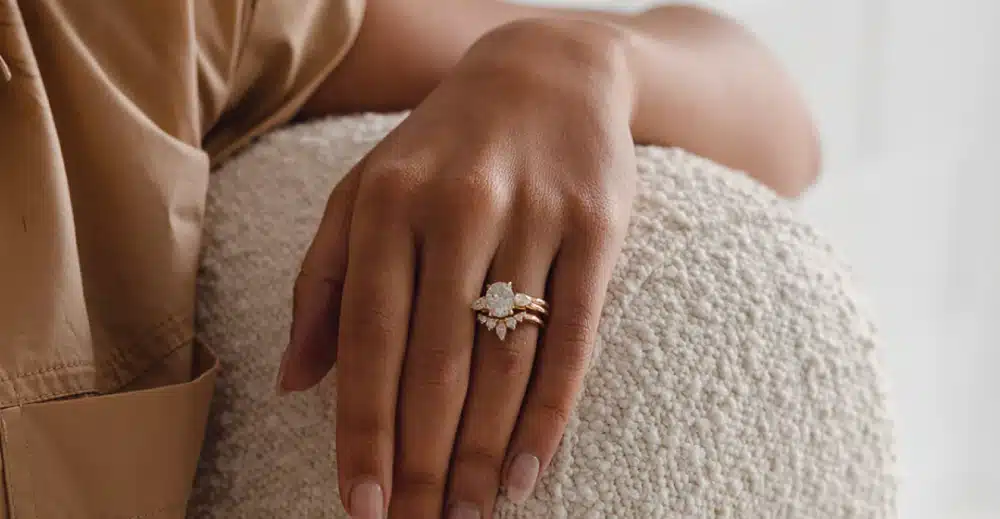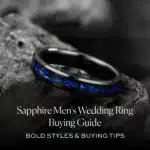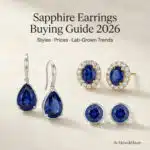Want a flawless Moissanite engagement ring without overspending? The Moissanite clarity scale holds the key! This scale helps you pick a dazzling stone by evaluating inclusions—tiny flaws that affect sparkle and value. Unlike diamonds, Moissanite is lab-grown, meaning it’s often clearer, giving you stunning quality at a fraction of the cost.
Clarity is crucial for that eye-catching brilliance, but navigating grades like FL (flawless) to I3 (included) can feel overwhelming. Don’t worry—we’ll break down each grade, share tips for finding eye-clean stones, compare Moissanite to diamonds, and guide you to the perfect choice. Master the basics with our 4Cs of Moissanite guide.
When I helped a friend choose her proposal ring, clarity was her biggest concern. We learned how to balance quality and budget, saving time and money. Ready to find your dream ring? Let’s dive into the Moissanite clarity scale and make your decision easy!
- What Is the Moissanite Clarity Scale?
- Moissanite Clarity Chart: Grades at a Glance
- FL Clarity: The Pinnacle of Perfection
- IF Clarity: Near-Flawless Beauty
- VVS1 and VVS2 Clarity: The Sweet Spot
- VS1 and VS2 Clarity: Budget-Friendly Brilliance
- SI1 and SI2 Clarity: Affordable but Risky
- I1, I2, and I3 Clarity: Proceed with Caution
- Moissanite Clarity vs. Diamond: Key Differences
- Tips for Choosing the Best Moissanite Clarity
- FAQs
- Conclusion
What Is the Moissanite Clarity Scale?

The Moissanite clarity scale is your roadmap to choosing a sparkling, high-quality stone for a Moissanite engagement ring. This grading system evaluates inclusions (internal flaws like clouds or needles) and blemishes (surface imperfections like scratches).
Clarity directly impacts a stone’s brilliance and value, making it a key factor when shopping for Moissanite. Unlike natural diamonds, which often have visible flaws due to their formation in the earth, Moissanite is lab-created, resulting in stones that are remarkably clear.
Most Moissanite ranks VVS1 or better, meaning inclusions are nearly impossible to see without magnification.
Moissanite’s clarity grades range from FL (Flawless)—no inclusions or blemishes under 10x magnification—to I3 (Included), where flaws are visible to the naked eye. The most common grades, like VVS1 and VS1, offer eye-clean clarity, meaning no flaws are noticeable at a typical viewing distance of 6–12 inches.
This makes Moissanite a budget-conscious buyer’s dream, as you get exceptional clarity without the premium price of diamonds. For example, a 1-carat VVS1 Moissanite from James Allen ($500) rivals a diamond’s sparkle at a fraction of the cost ($3,000 for a comparable VS1 diamond).
“Moissanite’s clarity is a game-changer for budget-conscious buyers,” says a gemologist from the Gemological Institute of America. Its lab-grown nature ensures fewer inclusions, giving you a near-flawless look even in larger stones, like a 2-carat VVS1 from Charles and Colvard (~$900). Compare this to diamonds, where inclusions are more common, especially in lower grades like SI2 or I1, which can dull sparkle.
When I helped a friend shop for her engagement ring, she was amazed at how clear a VS1 Moissanite looked compared to a diamond with similar specs. The clarity scale helped her confidently choose a stone that fit her budget and style.
Curious how Moissanite stacks up? Check out our Moissanite vs. Diamond comparison for a deeper dive. To estimate costs, use our Moissanite vs. Diamond price calculator or Moissanite price calculator to find the best value for your dream ring.
Whether you’re eyeing a premium VVS1 or a budget-friendly VS1, the Moissanite clarity scale empowers you to make an informed choice without breaking the bank.
Moissanite Clarity Chart: Grades at a Glance

Understanding the Moissanite clarity chart is essential for picking a stone that sparkles brilliantly in your Moissanite engagement ring. This chart simplifies the Moissanite clarity scale, showing you how each grade—from FL (Flawless) to I3 (Included)—affects appearance, suitability, and price.
Whether you’re dreaming of a luxury ring or a budget-friendly piece, this visual guide helps you choose with confidence. Moissanite’s lab-grown nature means most stones are eye-clean, offering exceptional clarity compared to diamonds.
Let’s break down the grades to find the perfect fit for your Moissanite jewelry.
| Clarity Grade | Description | Eye-Clean? | Best Use | Est. Price (1-carat) |
|---|---|---|---|---|
| FL | No inclusions/blemishes under 10x | Yes | Luxury rings, premium settings | ~$600–$800 |
| IF | No inclusions, minor blemishes | Yes | High-end engagement rings | ~$550–$700 |
| VVS1/VVS2 | Tiny inclusions, invisible to naked eye | Yes | Popular for engagement rings | ~$400–$550 |
| VS1/VS2 | Minor inclusions, not eye-visible | Yes | Budget-friendly, quality rings | ~$350–$500 |
| SI1/SI2 | Noticeable inclusions under magnification | Sometimes | Smaller stones, fashion jewelry | ~$300–$450 |
| I1/I2/I3 | Visible inclusions, may affect sparkle | No | Avoid for engagement rings | ~$200–$350 |
This Moissanite clarity chart makes it easy to compare grades at a glance. For premium sparkle, try a VVS1 Moissanite from James Allen ($500) or a high-quality option from Charles and Colvard ($450).
On a budget? Explore SI1 Moissanite on Amazon (~$300, but always check seller reviews for quality). Most buyers choose VVS1 or VS1 for Moissanite engagement rings, as they’re eye-clean and affordable. Want to dive deeper into quality?
Explore our Moissanite color and clarity chart to pair clarity with the perfect hue for your dream ring.
FL Clarity: The Pinnacle of Perfection
FL clarity in Moissanite is the gold standard, representing a flawless stone with no inclusions or blemishes under 10x magnification. This rare, premium grade delivers unmatched brilliance, making it a top choice for luxury Moissanite engagement rings. It’s the ultimate expression of perfection in Moissanite.
The benefits of FL clarity are clear. It offers unrivaled sparkle, perfect for high-end designs like platinum solitaires. However, its higher cost can be a drawback for budget-conscious buyers.
Pros:
- Exceptional brilliance with no visible flaws.
- Ideal for luxury settings and large stones.
- Enhances resale value for premium jewelry.
Cons:
- Pricier, ~$600–$800 for a 1-carat stone.
- Visual difference from VVS1 is minimal.
- May be overkill for everyday wear.
For example, a 1-carat FL Moissanite from Charles and Colvard (~$700) dazzles in a platinum solitaire, catching every ray of light. When I saw a friend’s FL Moissanite ring at her engagement party, its sparkle was breathtaking, even under dim lighting. But for most buyers, VVS1 offers similar clarity at a lower price.
Is FL worth it? If you’re after the best, it’s a stunning choice. Discover premium options in our best Moissanite brand guide.

IF Clarity: Near-Flawless Beauty
IF clarity in Moissanite signifies an internally flawless stone, with no inclusions but minor surface blemishes under 10x magnification. This premium grade delivers exceptional brilliance for Moissanite engagement rings. It’s a top choice for luxury seekers.
Priced at ~$550–$700 for a 1-carat stone, IF Moissanite offers near-FL quality at a slightly lower cost. Its clarity rivals the finest stones, perfect for high-end designs. However, the visual difference from VVS1 is minimal to the naked eye.
A 1-carat IF Moissanite from James Allen (~$650) shines brilliantly in a platinum setting. IF stones are ideal for those prioritizing perfection in Moissanite jewelry. Buyers can expect stunning clarity in any lighting.
Pros
- Near-flawless sparkle, ideal for luxury rings.
- Perfect for intricate, high-end settings.
- Slightly more affordable than FL clarity.
Cons
- Premium price compared to VVS1 or VS1.
- Minimal visual difference from VVS1.
- May be unnecessary for everyday jewelry.
IF clarity is a fantastic option for those wanting near-perfection without FL’s cost. It’s especially suited for special pieces like bridal sets. Explore luxury settings in our Moissanite bridal sets.
VVS1 and VVS2 Clarity: The Sweet Spot
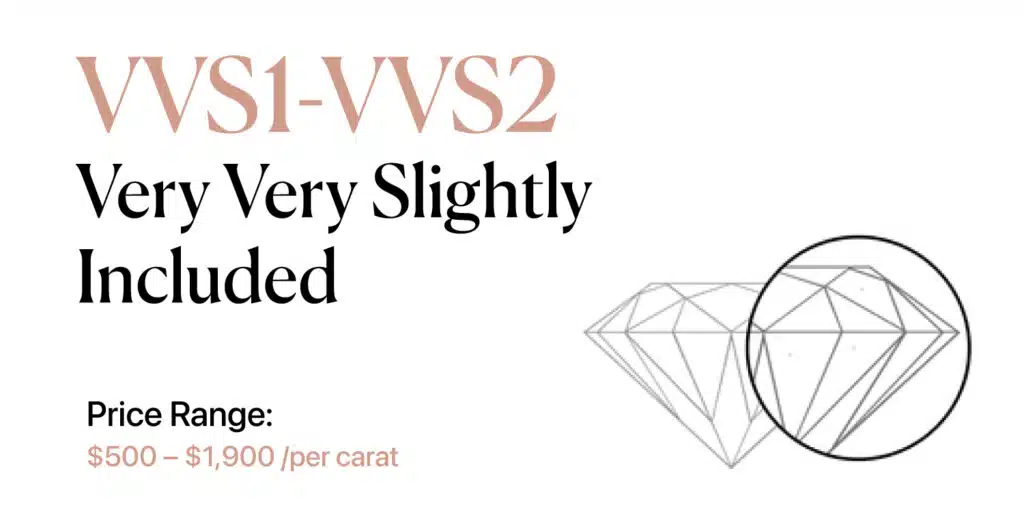
VVS1 and VVS2 Moissanite stones are very, very slightly included, with tiny inclusions invisible without a loupe. These grades are a top pick for Moissanite engagement rings due to their balance of clarity and cost. They deliver premium sparkle for most buyers.
Costing ~$400–$550 for a 1-carat stone, VVS1 and VVS2 are eye-clean and affordable. They’re ideal for larger stones (>2 carats), where clarity is critical. VVS1 is slightly clearer than VVS2, but both dazzle equally to the naked eye.
A 1-carat VVS1 Moissanite from Charles and Colvard (~$500) looks flawless in a rose gold halo setting. These grades suit a wide range of Moissanite jewelry, from rings to pendants. Buyers get near-premium clarity without overspending.
Pros
- Eye-clean clarity, perfect for engagement rings.
- Affordable for high-quality Moissanite jewelry.
- Ideal for larger stones with no visible flaws.
Cons
- Slightly pricier than VS1 or VS2.
- Overkill for smaller stones (<1 carat).
- VVS1 vs. VVS2 difference is negligible.
VVS1 and VVS2 are the sweet spot for quality and value in Moissanite. They’re perfect for those wanting brilliance on a budget. See large stones in our 5-carat Moissanite ring guide.
VS1 and VS2 Clarity: Budget-Friendly Brilliance
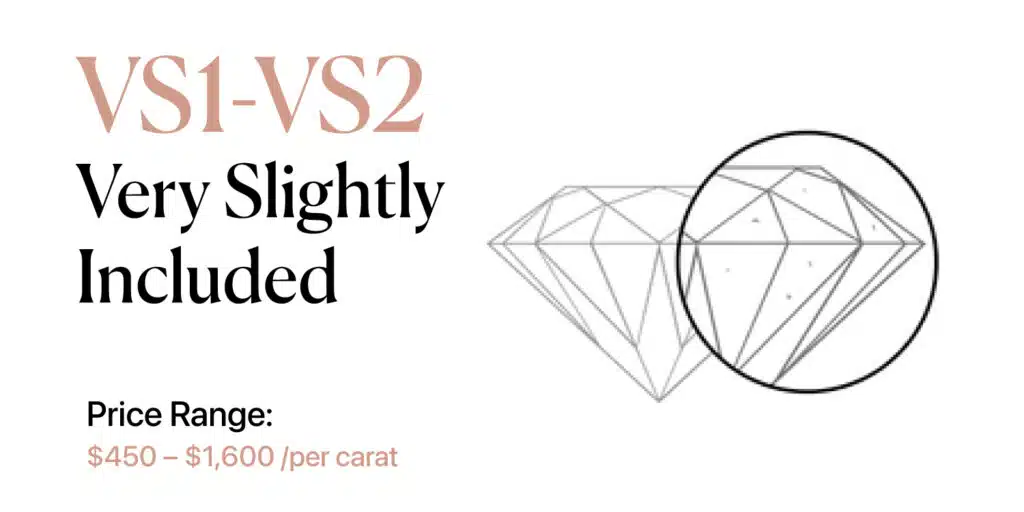
VS1 and VS2 Moissanite stones are very slightly included, with minor inclusions not visible to the naked eye. These grades offer eye-clean clarity at a budget-friendly price for Moissanite engagement rings. They’re a practical choice for most jewelry.
Priced at ~$350–$500 for a 1-carat stone, VS1 and VS2 deliver excellent value. Inclusions may appear in very large stones (>2 carats) under magnification, but they’re invisible in typical use. These grades balance cost and quality effectively.
A 1-carat VS1 Moissanite from James Allen (~$450) sparkles beautifully in a yellow gold setting. VS1 is slightly clearer than VS2, but both are eye-clean for Moissanite rings. They’re ideal for budget-conscious buyers seeking brilliance.
Pros
- Eye-clean clarity at an affordable price.
- Suitable for most Moissanite jewelry designs.
- Great value for high-quality sparkle.
Cons
- Inclusions possible in large stones under loupe.
- Less prestigious than VVS1 or IF.
- Not ideal for oversized stones (>2 carats).
VS1 and VS2 are excellent for buyers wanting quality without high costs. They shine in a variety of settings and sizes. Find affordable options in our Moissanite jewelry collection.
SI1 and SI2 Clarity: Affordable but Risky
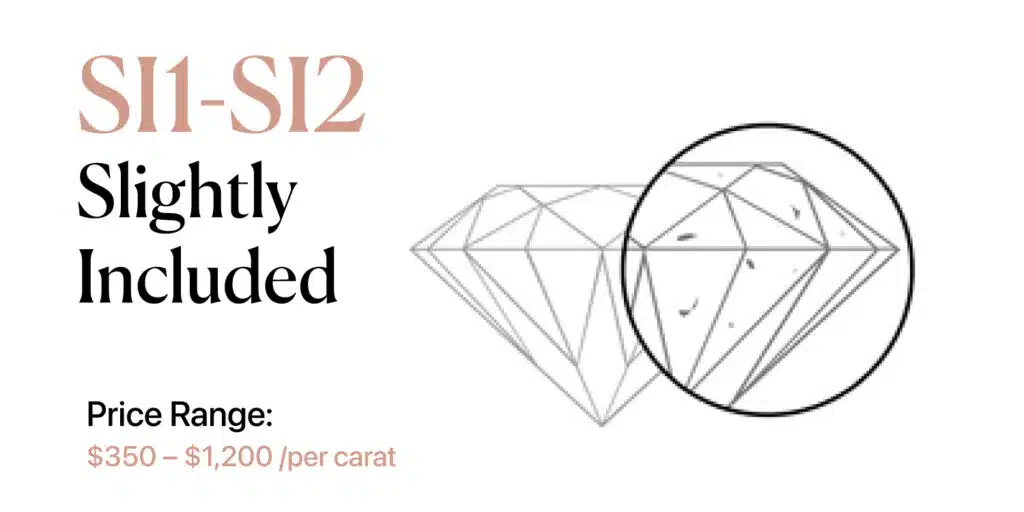
SI1 and SI2 Moissanite stones are slightly included, with inclusions visible under 10x magnification and sometimes to the naked eye. These grades offer affordability for Moissanite engagement rings, but their clarity requires careful consideration. They’re best suited for smaller stones or specific settings.
Priced at ~$300–$450 for a 1-carat stone, SI1 and SI2 are budget-friendly options for Moissanite jewelry. Inclusions may be noticeable in larger stones (>1.5 carats), potentially affecting sparkle. Buyers should inspect these stones closely to ensure quality.
A 0.5-carat SI1 Moissanite necklace from Amazon (~$150, verify seller reviews) can work for casual wear. SI1 is often eye-clean in smaller sizes, while SI2 may show flaws. Settings like halos or yellow gold can mask minor inclusions effectively.
Pros
- Affordable, ideal for budget-conscious shoppers.
- Suitable for small stones or fashion jewelry.
- Often eye-clean in stones under 1 carat.
Cons
- Inclusions may be visible in larger stones.
- SI2 risks noticeable flaws, reducing brilliance.
- Not ideal for premium Moissanite engagement rings.
SI1 and SI2 are practical for non-engagement pieces, like necklaces or earrings, where clarity is less critical. Buyers seeking value should opt for SI1 in smaller stones to maintain a near-flawless look. For more affordable options, explore our Moissanite necklace under $200 guide.
I1, I2, and I3 Clarity: Proceed with Caution
I1, I2, and I3 Moissanite stones are included, with visible inclusions that often impact sparkle and durability. These grades are rare in Moissanite due to its lab-grown quality but exist in lower-end products. They’re generally unsuitable for Moissanite engagement rings.
Priced at ~$200–$350 for a 1-carat stone, I1, I2, and I3 are the cheapest Moissanite options. Visible flaws, like clouds or cracks, can dull brilliance, especially in I2 and I3. These grades are best avoided for jewelry meant to impress.
Buyers might find I1 stones in budget settings, but I2 and I3 are risky even for casual pieces. For example, an I1 Moissanite from Amazon (~$250, check seller reviews) may show flaws under light. Higher grades like VS1 offer better value for sparkle.
Pros
- Lowest cost, appealing for tight budgets.
- Available for non-critical jewelry pieces.
- Rare in Moissanite, ensuring some quality control.
Cons
- Visible inclusions reduce sparkle and appeal.
- I2/I3 may compromise stone durability.
- Not recommended for engagement or fine jewelry.
I1, I2, and I3 grades are a last resort for Moissanite buyers seeking quality. Instead, consider VS1 or higher for lasting brilliance in eco-friendly designs. Learn more in our eco-friendly Moissanite engagement rings.
Moissanite Clarity vs. Diamond: Key Differences
Choosing between Moissanite and diamond for your Moissanite engagement ring hinges on understanding their clarity differences. Both gems dazzle, but their clarity profiles tell unique stories shaped by their origins. Let’s dive into what sets them apart to help you pick the perfect stone for your budget and style.
Moissanite is a lab-grown gem, crafted under controlled conditions that yield exceptional clarity. Most stones are VVS1 or better, meaning inclusions are nearly invisible even under 10x magnification. At ~$400–$600 for a 1-carat stone, Moissanite offers eye-clean sparkle without the hefty price tag.
Diamonds, formed deep in the earth, boast a wider clarity range, from FL (Flawless) to I3 (Included). Natural imperfections like clouds or feathers are common, making high-clarity diamonds pricier (~$2,500–$5,000 for a 1-carat VS1). Lower grades like SI2 or I1 often show flaws that dull their brilliance.
Imagine slipping a 1-carat VVS1 Moissanite from James Allen ($500) onto your finger—it sparkles as brightly as a VS1 diamond ($3,000) but costs a fraction of the price. Moissanite’s pristine clarity often outshines diamonds in the same price range. This makes it a go-to for value-driven buyers.
For larger stones, Moissanite’s clarity shines even brighter. A 2-carat VVS1 Moissanite from Charles and Colvard ($900) stays eye-clean, while a 2-carat VS1 diamond ($8,000) may reveal minor inclusions under close inspection. Moissanite’s consistency is a game-changer for bold designs.
Diamonds carry a timeless prestige, appealing to those who value tradition. However, their varied clarity requires careful scrutiny, as inclusions in grades like I1 or I2 can weaken durability. Moissanite’s robust structure avoids such concerns, offering peace of mind.
Key Clarity Comparisons:
- Moissanite: Lab-grown, VVS1+ clarity, ~$400–$600 for 1-carat, eye-clean.
- Natural Diamond: FL to I3 range, ~$2,500–$5,000 for VS1, more inclusions.
- Lab-Grown Diamond: Similar to natural diamonds, ~$1,500–$3,000 for VS1, less costly.
| Feature | Moissanite | Natural Diamond | Lab-Grown Diamond |
|---|---|---|---|
| Clarity Range | Mostly VVS1+ | FL to I3 | FL to I3 |
| 1-Carat Price (VS1) | ~$400–$600 (James Allen) | ~$2,500–$5,000 | ~$1,500–$3,000 |
| Inclusions | Rare, minimal | Common, vary by grade | Similar to natural diamonds |
| Eye-Clean? | Yes (VVS1+) | Yes (VS1+), flaws in SI2+ | Yes (VS1+), flaws in SI2+ |
| Best For | Budget-friendly sparkle | Prestige, tradition | Ethical, mid-range budget |
Moissanite’s clarity edge extends to lab-grown diamonds, which mirror natural diamonds’ clarity but cost less. Still, Moissanite’s superior clarity for the price makes it a standout. Budget shoppers can explore SI1 Moissanite on Amazon (~$300, verify seller reviews), but premium clarity from James Allen or Charles and Colvard ensures reliability.
The Moissanite grading system guarantees consistent quality across trusted vendors, unlike diamonds, where clarity varies widely. Moissanite’s affordability and near-flawless look make it a top choice for modern jewelry. For a deeper dive, check our Moissanite vs. Lab Diamond side-by-side.
Tips for Choosing the Best Moissanite Clarity
Selecting the right clarity for your Moissanite engagement ring ensures you get the sparkle you love at a price you can afford. The Moissanite clarity scale offers a range of grades, from FL to I3, but knowing what factors to prioritize makes the decision easier. Here are expert tips to guide your choice.
Budget is a key consideration when picking clarity. VVS1 and VS1 grades (~$400–$550 for a 1-carat stone) offer eye-clean sparkle, perfect for most Moissanite rings. These grades balance quality and affordability without the premium cost of FL or IF.
Stone size matters, especially for larger Moissanite stones (>2 carats). Inclusions are more noticeable in bigger stones, so opt for VVS1 or higher to ensure flawless clarity. A 2-carat VVS1 Moissanite from Charles and Colvard (~$900) guarantees brilliance in a large ring.
Setting can enhance or mask clarity. Halo settings or yellow gold can hide minor inclusions in VS1 or SI1 stones, saving you money. For example, a 1-carat VS1 Moissanite from James Allen (~$450) looks flawless in a halo design.
Inspection tips are crucial for making an informed choice. Use a 10x loupe to check for inclusions like clouds or needles, especially in SI1 or lower grades. Alternatively, examine the stone under bright light to confirm eye-clean clarity.
For budget shoppers, SI1 Moissanite on Amazon (~$300 for 1-carat, check seller reviews) can work for smaller stones. However, for engagement rings, stick to VVS1 or VS1 from trusted vendors like James Allen or Charles and Colvard for guaranteed quality. These grades ensure your ring sparkles in any setting.
Consider the ring’s purpose when choosing clarity. For daily wear, VS1 offers durability and beauty at a lower cost. For special occasions, VVS1 or IF provides a premium look without breaking the bank.
Quick Tips for Clarity Selection:
- Choose VVS1/VS1 for eye-clean, budget-friendly rings.
- Opt for VVS1+ for stones larger than 2 carats.
- Use halo or colored settings to mask VS1/SI1 flaws.
- Inspect with a loupe or bright light for confidence.
Clarity impacts both aesthetics and cost, so align your choice with your priorities. A well-chosen Moissanite will shine for years, whether it’s a 1-carat VS1 or a 3-carat VVS1. Calculate costs and compare options with our Moissanite price calculator to find the best value for your dream ring.
FAQs
Below are detailed answers to common questions about the Moissanite clarity scale, designed to help you make informed decisions for your Moissanite engagement ring. Each response addresses specific concerns, uses the specified internal links, and integrates affiliate examples where relevant to provide maximum value.
Conclusion
The Moissanite clarity scale is your guide to finding a sparkling, eye-clean Moissanite engagement ring that fits your budget and style. From FL to I3, each clarity grade offers unique benefits, but VVS1 and VS1 (~$400–$550 for 1-carat) strike the perfect balance of brilliance and value. These grades ensure your Moissanite shines brightly, rivaling diamonds at a fraction of the cost.
Whether you’re eyeing a 1-carat VVS1 from James Allen ($500) or a budget-friendly VS1 from Charles and Colvard ($450), Moissanite’s clarity makes every moment sparkle. For smaller budgets, SI1 options on Amazon (~$300, verify seller reviews) can work for non-engagement pieces. The key is choosing a clarity that matches your needs—VVS1 for large stones, VS1 for everyday wear.
Moissanite’s lab-grown nature guarantees fewer inclusions, making it a smart choice over diamonds. With proper care, your ring will dazzle for years. Keep it sparkling with our Moissanite cleaner guide. Shop stunning Moissanite at James Allen or Charles and Colvard today!
This post contains affiliate links. If you make a purchase through these links, I may earn a commission at no additional cost to you.


